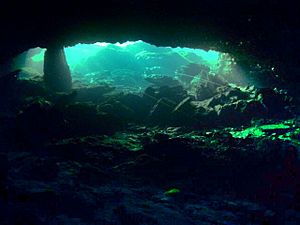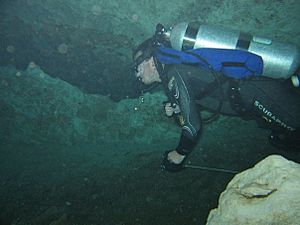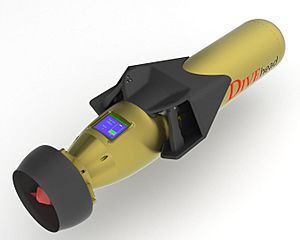Cave diving facts for kids

Cave diving is a special type of underwater diving where people explore caves that are filled with water. It can be an exciting sport, a way to discover new parts of flooded caves for science, or a search mission to find lost divers. Most cave diving uses scuba equipment, often set up in unique ways for the cave environment. Because you can't just swim straight up to the surface in a cave, it's considered a type of technical diving.
Cave diving is not as common as regular scuba diving or caving (exploring dry caves). This is because it needs very specific gear and skills. It also has higher risks due to the unique challenges of diving inside a cave.
Even with the risks, water-filled caves attract divers and scientists. They are often unexplored and offer a big challenge. Underwater caves can have amazing features and even special animals not found anywhere else.
Contents
How Do Cave Divers Explore?
Cave diving has many steps that are similar to other types of diving inside enclosed spaces. However, there's a big focus on finding your way, managing your air, and moving in tight spots. Unlike open water, you cannot just swim up to the surface.
Finding Your Way Out
Since there's no open surface with air in a cave, it's super important to find your way out before you run out of breathing gas. Divers use a continuous line, called a guideline, that connects them to the outside of the cave. They also carefully plan and watch their air supply.
There are two main types of guidelines:
- Permanent lines: These are already set up in the cave. They often have markers that point the way to the nearest exit.
- Temporary lines: Divers lay these lines themselves, especially when exploring new areas. They also use short "jump lines" to cross gaps between permanent lines.
Special Skills Needed
Many regular diving skills are important for cave diving, but there are extra skills needed for this environment:
- Buoyancy control: Being able to float perfectly and move smoothly helps keep the water clear, especially if there's a lot of silt (fine mud) on the cave floor.
- Navigation: Divers must be able to find their way in total darkness using only the guideline. This is a critical emergency skill.
- Line management: This includes laying and collecting guidelines using a reel, tying off the line, and knowing how to deal with a broken line.
- Emergency skills: Dealing with air problems is harder in tight spaces, low visibility, or darkness.
Training to Be a Cave Diver
Cave diving training teaches divers about equipment, how to use guidelines, manage air, and communicate underwater. It also focuses on managing risks and protecting the cave environment. Training usually happens in stages:
- Cavern training: This is the first step. It teaches basic skills for diving near the cave entrance where natural light is still visible. Divers learn about air planning, special ways to kick to avoid stirring up silt, and how to use reels.
- Introduction to cave training: This builds on cavern skills. Divers learn to go deeper into the cave and use permanent guidelines.
- Apprentice cave training: This stage helps divers go even deeper and learn about more complex dive planning. They can also make a single "jump" (cross a gap) between guidelines.
- Full cave training: This is the final basic level. Certified full cave divers can explore deep into cave systems, use different guidelines, and plan complex dives. They can also make multiple jumps between lines.
What Are the Dangers of Cave Diving?
Cave diving is one of the most challenging types of diving. It has many dangers. Because you are inside a cave, you cannot just swim straight up to the surface in an emergency. You must swim all the way back out. Finding your way through the cave can be hard, and the exit might be far away. This means divers need enough breathing gas to get back safely.
Visibility and Darkness
The water can be very clear or very murky, and it can change quickly. True cave diving goes far beyond where sunlight can reach. It's completely dark, so divers rely on artificial lights. Caves often have sand, mud, or silt that can make the water cloudy in seconds if stirred up.
Water Currents
Caves can have strong water currents. Some caves are "springs" where water flows out, and others are "siphons" where water flows in. Some caves have both. If divers don't manage these currents properly, they can cause serious problems.
Is It Really That Dangerous?
Cave diving is often seen as very dangerous. However, many accidents happen to divers who haven't had special training or don't have the right equipment. Many experienced cave divers believe it can be safer than regular diving because of the strict training and equipment needed. There isn't a full worldwide list of all cave diving accidents. But the information available suggests that very few divers get hurt when they follow the rules and use proper gear.
How Do Cave Divers Stay Safe?
Most cave divers follow five main rules for safe cave diving. These rules became popular from a book by Sheck Exley in 1979. He studied many cave diving accidents and found common reasons why they happened. These five rules are the most important:
- Training: A safe cave diver never tries to do more than what they are trained for. Cave diving training builds up step by step. Divers gain experience after each stage before moving to the next. This helps them stay calm and act correctly in an emergency.
- Guideline: Divers always keep a continuous guideline between their team and a fixed point outside the cave. This line helps them find their way back, especially if the water gets cloudy. Not using a continuous guideline is a common reason for accidents among untrained divers.
- Depth Rules: Going deeper uses more air and can cause problems like nitrogen narcosis (feeling dizzy or confused). Cave divers must stick to their planned depth and the limits of their equipment and breathing gases. Diving too deep is often a factor in accidents, even for trained divers.
- Breathing Gas Management: Divers must have enough air to get out of the cave. A common rule is the "rule of thirds." This means using one-third of your air to go in, one-third to come out, and keeping one-third as a reserve for emergencies. Some divers keep even more air in reserve, especially if the cave has no outflow current.
- Lights: Every cave diver should have at least three independent light sources. One is the main light, and the others are backups. Each light must last for the entire planned dive. If any diver loses a light and has fewer than three working lights, the whole team must end the dive and exit the cave immediately.
Cave divers use a special saying to remember these five rules: "The Good Divers Always Live."
In recent years, new factors have been looked at, like diving alone, diving with less experienced partners, or diving in very large groups. Also, using different gas mixtures for deep dives means divers must be very careful to use the correct gas.
Warning signs, sometimes showing a Grim Reaper, are placed at the entrances of many popular caves in the US. These signs warn people about the dangers. Many dive sites also have a "no-lights rule" for divers without cave training. This rule helps prevent untrained divers from going too far into the dark parts of a cave.
What Equipment Do Cave Divers Use?
Cave divers use a variety of special equipment. Some gear is similar to regular scuba diving, but other items are designed for the unique challenges of caves. This equipment helps divers move freely in tight spaces, stay underwater longer, travel greater distances, and navigate in dark, winding passages.
Common equipment setups for cave diving include:
- Twin cylinders: Divers often carry two air tanks, either connected or separate, for more air and safety.
- Side-mount harnesses: This setup places tanks on the diver's sides, which helps them fit through narrow passages.
- Sling cylinders: Extra tanks carried by hand or clipped to the diver.
- Rebreathers: These devices recycle breathing gas, allowing for much longer dives and less gas consumption.
- Backplate and wing harnesses: A comfortable and flexible system for carrying tanks.
Stage cylinders are extra air tanks that divers can leave along the guideline to pick up later. This helps them carry less weight at the start of a long dive.
Guidelines are essential for safety. Divers use cave reels to lay and retrieve these lines. For gaps between permanent lines, they use gap spools with a short line to connect them.
Line arrows are small markers placed on the guideline to point the way to the nearest exit. Cookies are small, unique markers used by a dive team to show that they are using a particular line.
Silt screws are used to tie off a guideline when there are no natural places to attach it. They are pushed into the soft cave floor.
Diver propulsion vehicles (DPVs), also called scooters, help divers travel faster and cover more distance in open parts of the cave. They reduce how much work the diver has to do.
Dive lights are critical because caves are completely dark. Each diver carries a main light and at least two backup lights. All lights must last for the entire dive.
A Brief History of Cave Diving
Jacques Cousteau, who helped invent the first successful scuba equipment, was one of the first people to use scuba to dive in caves. However, people explored caves with surface-supplied air (from hoses connected to the surface) even before scuba gear existed. Scuba diving, including cave diving, has come a long way since Cousteau introduced the Aqua-Lung in 1943.
Images for kids
-
Cave diving equipment from 1935 in the museum at Wookey Hole Caves
-
Cave diving equipment in the museum at Wookey Hole Caves
See also
 In Spanish: Espeleobuceo para niños
In Spanish: Espeleobuceo para niños














